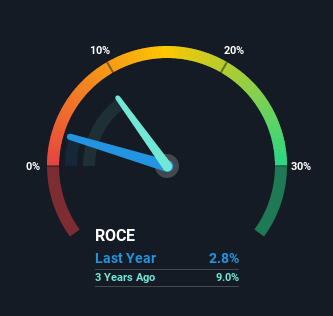- Poland
- /
- Industrials
- /
- WSE:GKI
Returns On Capital At Grupa Kapitalowa IMMOBILE (WSE:GKI) Have Hit The Brakes

If we want to find a stock that could multiply over the long term, what are the underlying trends we should look for? Amongst other things, we'll want to see two things; firstly, a growing return on capital employed (ROCE) and secondly, an expansion in the company's amount of capital employed. Put simply, these types of businesses are compounding machines, meaning they are continually reinvesting their earnings at ever-higher rates of return. In light of that, when we looked at Grupa Kapitalowa IMMOBILE (WSE:GKI) and its ROCE trend, we weren't exactly thrilled.
Return On Capital Employed (ROCE): What is it?
For those who don't know, ROCE is a measure of a company's yearly pre-tax profit (its return), relative to the capital employed in the business. Analysts use this formula to calculate it for Grupa Kapitalowa IMMOBILE:
Return on Capital Employed = Earnings Before Interest and Tax (EBIT) ÷ (Total Assets - Current Liabilities)
0.028 = zł15m ÷ (zł858m - zł323m) (Based on the trailing twelve months to September 2021).
Thus, Grupa Kapitalowa IMMOBILE has an ROCE of 2.8%. Ultimately, that's a low return and it under-performs the Industrials industry average of 6.9%.
View our latest analysis for Grupa Kapitalowa IMMOBILE

Historical performance is a great place to start when researching a stock so above you can see the gauge for Grupa Kapitalowa IMMOBILE's ROCE against it's prior returns. If you want to delve into the historical earnings, revenue and cash flow of Grupa Kapitalowa IMMOBILE, check out these free graphs here.
So How Is Grupa Kapitalowa IMMOBILE's ROCE Trending?
In terms of Grupa Kapitalowa IMMOBILE's historical ROCE trend, it doesn't exactly demand attention. The company has employed 144% more capital in the last five years, and the returns on that capital have remained stable at 2.8%. Given the company has increased the amount of capital employed, it appears the investments that have been made simply don't provide a high return on capital.
Another point to note, we noticed the company has increased current liabilities over the last five years. This is intriguing because if current liabilities hadn't increased to 38% of total assets, this reported ROCE would probably be less than2.8% because total capital employed would be higher.The 2.8% ROCE could be even lower if current liabilities weren't 38% of total assets, because the the formula would show a larger base of total capital employed. So while current liabilities isn't high right now, keep an eye out in case it increases further, because this can introduce some elements of risk.
The Bottom Line
As we've seen above, Grupa Kapitalowa IMMOBILE's returns on capital haven't increased but it is reinvesting in the business. Additionally, the stock's total return to shareholders over the last five years has been flat, which isn't too surprising. All in all, the inherent trends aren't typical of multi-baggers, so if that's what you're after, we think you might have more luck elsewhere.
Since virtually every company faces some risks, it's worth knowing what they are, and we've spotted 3 warning signs for Grupa Kapitalowa IMMOBILE (of which 2 are significant!) that you should know about.
While Grupa Kapitalowa IMMOBILE may not currently earn the highest returns, we've compiled a list of companies that currently earn more than 25% return on equity. Check out this free list here.
New: Manage All Your Stock Portfolios in One Place
We've created the ultimate portfolio companion for stock investors, and it's free.
• Connect an unlimited number of Portfolios and see your total in one currency
• Be alerted to new Warning Signs or Risks via email or mobile
• Track the Fair Value of your stocks
Have feedback on this article? Concerned about the content? Get in touch with us directly. Alternatively, email editorial-team (at) simplywallst.com.
This article by Simply Wall St is general in nature. We provide commentary based on historical data and analyst forecasts only using an unbiased methodology and our articles are not intended to be financial advice. It does not constitute a recommendation to buy or sell any stock, and does not take account of your objectives, or your financial situation. We aim to bring you long-term focused analysis driven by fundamental data. Note that our analysis may not factor in the latest price-sensitive company announcements or qualitative material. Simply Wall St has no position in any stocks mentioned.
About WSE:GKI
Grupa Kapitalowa IMMOBILE
Operates in the industry, construction and development, hotel industry, clothing industry, and automation and power engineering in Poland and internationally.
Undervalued low.


